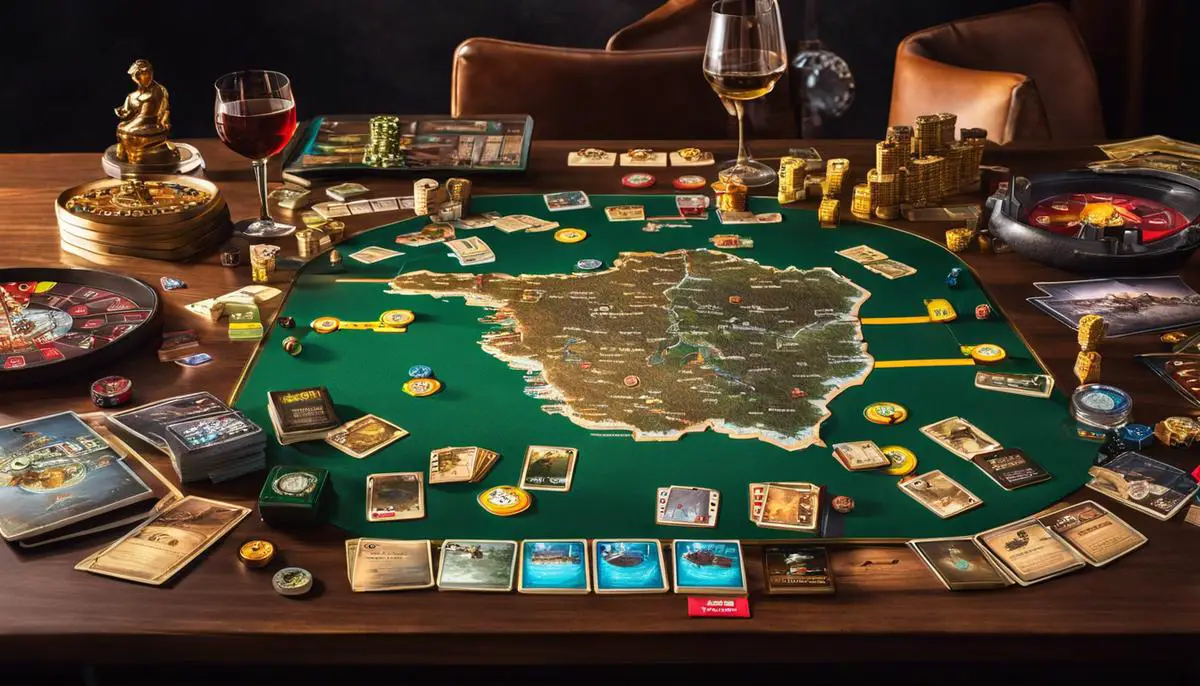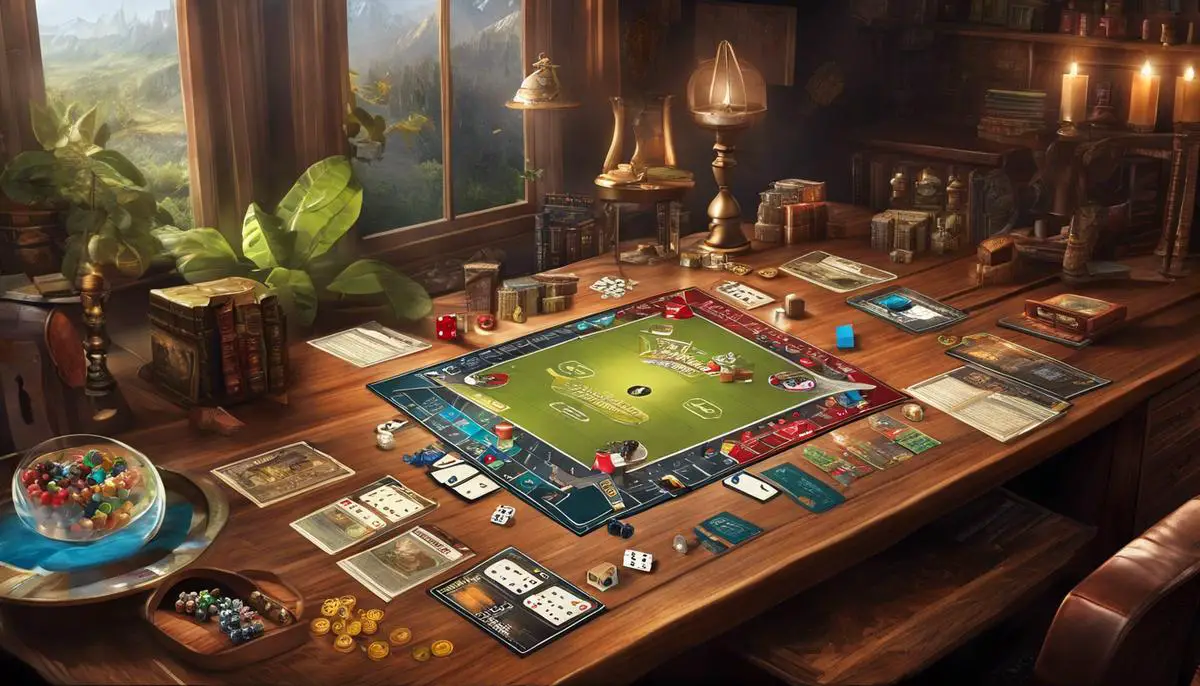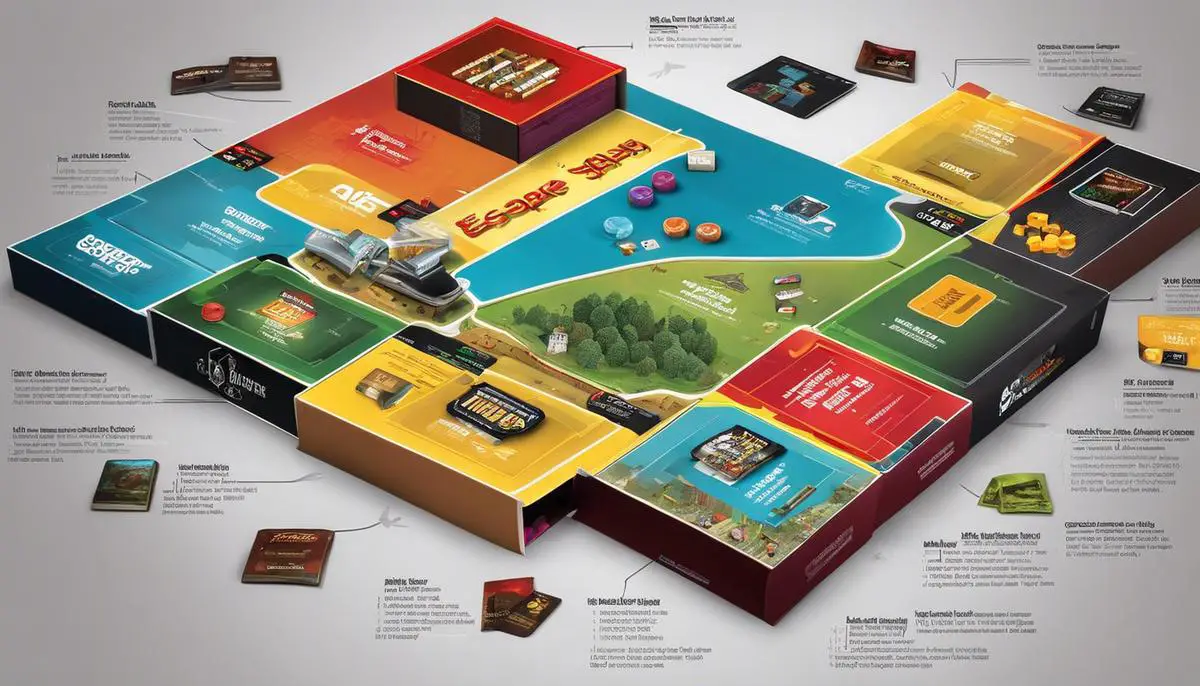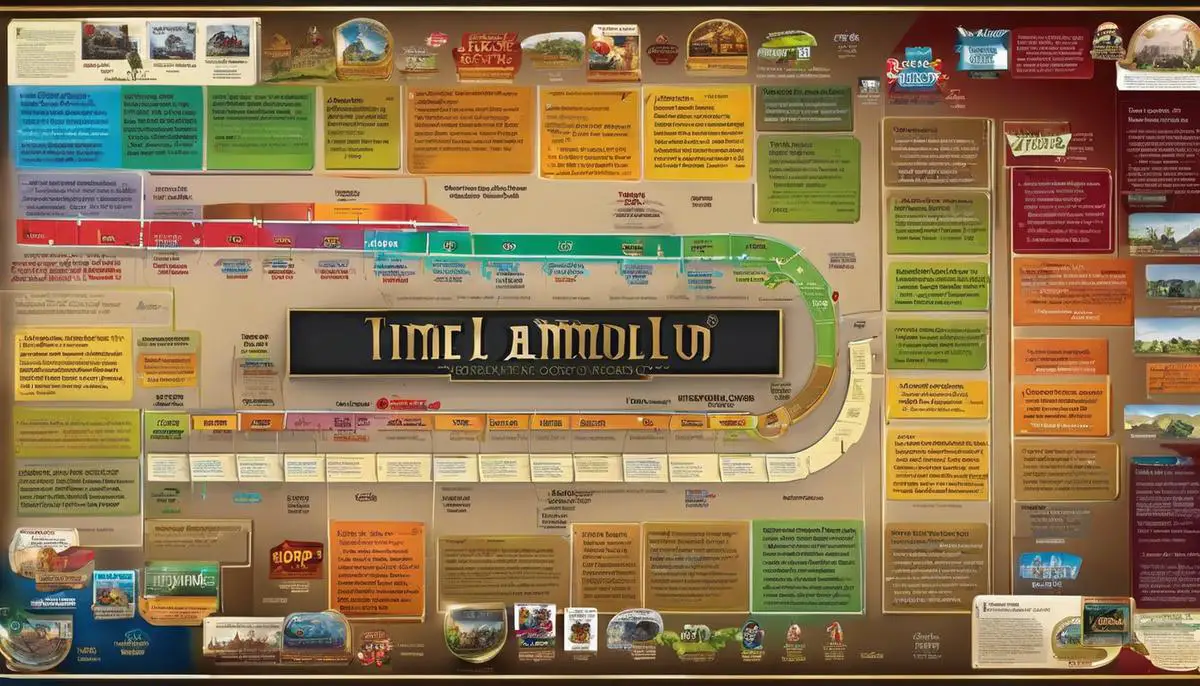Board games have long been a significant source of entertainment across generations, fueling friendly competition, fostering teamwork, and creating shared moments of joy. Some companies have left indelible marks in this industry’s trajectory, shaping the game landscape through relentless creativity and innovation. In exploring the history and origin of top board game brands, we travel back to their humble beginnings and follow their evolution into monumental success. We’ll dive into the diverse genres and varieties that these brands offer, encapsulating an array of tastes from strategy to education. Shining a spotlight on best-sellers and fan favorites, we’ll attempt to uncover the ‘magic formula’ behind a successful game. All the while, we’ll be appreciating the art and design elements that add a crucial layer to gameplay, and cast an eye towards future trends and innovations that continue to redefine the board game experience.
The History and Origin of Top Board Game Brands
How History Has Shaped Our Favorite Board Games
In the world of board games, several legendary names have emerged over the years; brands like Monopoly, Scrabble, and Clue have given us countless hours of entertainment. Little do the participants of such table-top fun realize, these games didn’t just magically appear. They were shaped and influenced by significant cultural and historical events, providing a rich backstory to some of our most beloved pastimes.
Who hasn’t journeyed through the real estate world of Monopoly? First patented in 1935 by Charles Darrow during the tail-end of The Great Depression, Darrow sold Monopoly as a comforting American Dream narrative – even amidst economic ruin, one could still become a property tycoon. The game’s road to success was fraught with duplicity and controversy. Initially, it was Elizabeth Magie who created “The Landlord’s Game” in 1903, aiming to critique the injustices of unchecked capitalism! A far cry from Darrow’s portrayal of capitalist aspiration.
Scrabble, a cherished brand, has elevated ‘game night’ into an exercise of intellectual prowess since its inception. Alfred Mosher Butts, an architect during the 1930s, had an unwavering fascination with language and statistics. Frustrated by the lack of vocabulary-based games in the market, he meticulously counted letter frequency in different texts and crafted a game that combined chance and strategy with the English language. Initially named “Criss-Crosswords,” it only hit commercial success after James Brunot, a game-loving entrepreneur, acquired the rights and renamed it “Scrabble” in 1948.
Then there’s Clue, a detective quest in your living room! Launched in 1949 by Anthony E. Pratt, a British musician, Clue was initially named “Cluedo.” During World War II, university-student Pratt worked in a munitions factory by day and by night, he attended secret parties as a way to distract from the wartime gloom. These mysterious gatherings, replete with pretend crimes and playful deduction, inspired him to create Cluedo. Strangely apt, Clue arrived in America during the McCarthy-era paranoia when finding culprits was all the rage.
It’s clear that the dramatic narrative of Risk, Monopoly’s portrayal of capitalism, Scrabble’s intellectual challenge, and Clue’s detective mystery all continue to entertain generations of board game enthusiasts. They’ve eclipsed the realm of leisurely pursuits, inevitably becoming cultural touchstones that both reflect and shape societal zeitgeist. Each roll of the dice, spin of the wheel, and shuffle of the cards is not just a play towards victory, it’s an unwitting engagement with the past and its legacies. The next time the game board’s spread, remember – every move made echoes a piece of history!

Diverse Genres and Varieties within Board Game Brands
Board games, beyond their roles as instruments of merriment, are exceptionally diverse and varied. Each game, from Monopoly to Clue, is a testament to this fact, carrying unique narratives that cater to audiences of all varieties — but this is only the tip of the iceberg. There are numerous board games, underpinned by diverse themes, that extend beyond these familiar names. These games, often branded and perfected by large companies, present complex worlds, invoking realms as varied as sprawling galactic empires in Twilight Imperium to intricate railroad systems in Ticket to Ride.
One of the striking features of branded board games is their ability to translate multifaceted real-world experiences into playable narratives. Take, for instance, Pandemic. Z-Man’s gem skillfully marries the thrill of board gaming and the complexities around viral epidemiology, providing an experience that’s both fun and enlightening. Imagine working tirelessly as specialized operatives, pooling various competencies to beat back the onslaught of a world-threatening disease!
Role-playing norms are also a highly appealing aspect of board games. Dungeons and Dragons, an endearing classic, offers an extensive framework for fantasy stories and character development. This game does an impeccable job of catering to enthusiasts with a preference for imagination and storytelling over competition. Naturally, board games encompassing such socially engaging experiences have promoted a burgeoning community of hobbyists.
Then there’s the strategists’ world. Chess and Go may have dominated this territory for centuries, but we’ve had many intriguing additions that challenge players’ critical thinking. Games like Settlers of Catan, with its perfectly balanced blend of strategy and chance, keep players of all skill levels enthralled, crafting empires on an ever-changing hexagonal board.
For those geared toward word-smithing, we salute Bananagrams, a fast-paced cousin of Scrabble. No need for a game-board, just a flat surface and the agility to churn out words, creating a constantly shifting word-grid. Truly an exhilarating ride for linguophiles!
Exploration of history doesn’t lag behind either. Look at games like Twilight Struggle, which spins the tension of the Cold War against the canvas of a board, or Freedom: The Underground Railroad, which offers a reflection into the painful yet powerfully heroic journey of slaves in 19th-century America.
Simply put, branded board games have evolved over time to offer a huge variety that caters to virtually every form of interest, be it strategic, linguistic, historical, or social. Evidently, these games serve as bridges, connecting realms of reality and imagination, while offering exciting, often unanticipated insights into various aspects of our world. This makes them a fascinating pastime, whether you’re seeking a family bond, a thrilling brain-race, or simply a window into another world. So, whether you’re an experienced hobbyist or a casual player, the diverse and varied arena of branded board games is likely to have more than one offering that will pique your interest.

The Best-Sellers and Fan-Favorite Games
In the realm of modern board gaming, the options are as diverse as the players themselves, crossing genres, themes, and even periods of history.
A noticeable trend in recent years has been the rise of branded board games. However, these are far from simple marketing ploys; they introduce new worlds, complex narratives and unique themes. Case in point is “Game of Thrones: The Board Game,” which captures the spirit and strategic nuance of the popular HBO series. It’s a war strategy game set in the living, breathing world of Westeros, allowing players to experience the battles, alliances, and deceit that fans of the series know so well.
Along with distinctive narratives there are board games that mimic real-world experiences, transforming them into compelling gameplay. “Pandemic,” a cooperative game where players must work together to stop global disease outbreaks, is an excellent example. It fosters teamwork, communication, and strategy, while also acting as a mirror to the public health crises we face in the real world.
Curious about stepping into somebody else’s shoes for a while? Role-playing board games like “Betrayal at House on the Hill” can fulfill this desire. In this game, players explore a haunted mansion, with one player eventually becoming the traitor. These games provide opportunities for immersive storytelling and allow players to flex their creative, strategic, and social muscle in varieties of game situations.
When we shift the focus from the worldbuilding and narrative to mental gymnastics, competitive strategy games take center stage. Intricately designed games like “Settlers of Catan” or “Ticket to Ride” are perfect examples. They test players’ abilities to plan, calculate risk, and react to unexpected developments – honing valuable cognitive skills while providing hours of fun.
For those with a penchant for words, games like “Bananagrams” are a fruitful pick. It’s a high-speed, competitive spelling game. Just like Scrabble, it combines the thrill of anagrams with an urgent race to complete your word grid first. Not only does it test a player’s knowledge of the language, but it requires fast, strategic thinking.
Certain games dive deep into unexplored territories of history. “Twilight Struggle,” encompassing the entire Cold War from 1945-1989, and “Freedom: The Underground Railroad,” focusing on a significant period in U.S history, are complex, cooperative board games that are as informative as they are entertaining.
Branded board games nowadays strive to cater to multiple player interests and skill sets – whether that’s strategic, linguistic, historical, or social. This focus on variety and inclusivity is a testament to how far board gaming has come as a hobby, continuously evolving and incorporating newer, engaging elements into gameplay.
Beyond just mere pastime, board games create spaces where reality and imagination intersect. They allow us to grapple with real-world concepts in a controlled environment, challenge our critical thinking skills, and give us the freedom to step into other narratives and identities.
It’s no surprise then that board games hold such a beloved place in our gaming hearts. They offer a fascinating, communal exploration of strategy, storytelling, history, and good, old-fashioned competition. And in a world that’s increasingly digital, there’s just something special about sitting around a table with friends or family, to throw some dice, draw some cards, and immerse yourself in a fantastic board game.

Exploring the Art and Design Of Board Games
While the historical and cultural dynamics of board games unfurl through the eons of Monopoly, Scrabble, and Clue, there exists another vital aspect that largely contributes to the success of these classic games – their art and design.
How is it that we are instinctively drawn to the ornate board of Clue, or the colorful property spaces of Monopoly, even before delving into the game rules? The answer lies in ‘Graphical UX‘ or Graphic User Experience. Akin to the digital world, aesthetic functionality plays a key role in the gaming realm as well. The design and art elements of a board game function as visual mnemonics that aid in immersing players into the game’s intended mood and world. Board games can step up their allure by paying detailed attention to their visual components – the game board, cards, game pieces, even the game box.
A remarkably designed board game facilitates usability, enriches the narrative, and significantly heightens playability. It’s all about bridging the gap between functionality and thematic representation. This sophistication was displayed in the wide-eyed owl tokens of ‘Forbidden Forest’, or the rustic sepia adorned cards of ‘Mysterium’ that complement their otherworldly mysteries. Good design involves thoughtful decision-making about color schemes, typography, iconography, and more, all contributing to creating an intuitive and enjoyable board game experience.
One might wonder, is it just the visual aspects that lend to the overall design of a great board game? Absolutely not! The textual contents of a game and their placement are just as essential. The art of word-smithing is widely employed to include clever puns, seeded clues, or even history-backed trivia that enrich the gaming experience, similar to what word-based games like Bananagrams and Scrabble have championed in the past.
In the realm of today’s board games, thematic integration is not just an added layer of appeal, it’s a necessity. The modern player seeks more than just a dice-rolling contest – they’re looking for storytelling, narrative arcs, and character development. Whether it’s the gritty political history in ‘Twilight Struggle’ or the emotionally charged journey in ‘Freedom: The Underground Railroad’, these board games tactfully bring an intricate web of real-world narratives onto a flat game board.
Designing a board game is similar to sculpting an interactive piece of art – every element should be purposeful. Advanced strategy games like ‘Agricola’ or ‘Settlers of Catan’ employ this approach by aligning their game mechanics and design so seamlessly that players are completely enthralled within their fabricated worlds.
To conclude, the art and design elements of board games have transformed into a complex craftsmanship that mirrors the evolution of player expectations, technological advancements, and cultural shifts. So, while board games continue to foster a sense of community and shared joy around the table, they also provide an enriched aesthetic experience that harmoniously melds the real and imaginary realms, making each gaming session a memorable adventure. And isn’t that a ‘roll of the dice’ worth taking?

Future Trends and Innovations in Board Games
In the 21st century, board games have crossed the boundaries of old-school entertainment into a new era of engaging, creative, and immersive gameplay experiences. With leaps and bounds in technology, as well as shifts in societal values, board games have drastically evolved–and they continue to do so. Looking towards the horizon, there are several intriguing factors that promise to reshape the board game industry.
First, let us explore the innovative features on the horizon for board games. As technology infiltrates traditional board games, they become ‘hybrid’ games, a fusion of physical components and digital interaction. These fresh concepts add value by integrating interesting dynamics and augmenting the gameplay experience. Imagine using a tablet or smartphone as part of a board game. Via an application, actions can be taken in real-time with immediate digital responses. For example, consider a detective-style board game where the digital component introduces sudden plot twists, secret missions, or unexpected clues hidden within barcodes or QR codes.
Nevertheless, technology isn’t the only catalyst evolving board games. Innovation is also evident in game mechanics. There’s a growing appetite for ‘Legacy games’, where gameplay and rules change over a sequence of game sessions based on players’ decisions and outcomes. This evolution significantly boosts long-term replayability, player engagement, and the empowerment of players to shape their gaming universe.
Next, is the surge of new genres in board gaming. Board games designed around cooperative play are gaining traction. Unlike typical competitive games where the goal is to beat other players, cooperative games invite players to work together to defeat the game itself. Successful examples include ‘Pandemic’ and ‘Spirit Island’. Another emerging genre is the ‘escape room’ board games. These games, such as ‘Exit: The Game”, provide an immersive puzzle-solving experience that players can enjoy in the comfort of their own homes.
A relatively newer category is ‘microgames’ – compact, quick-to-play games that still offer strategic depth. They typically feature minimalist designs and rules that can be picked up within minutes, making them excellent for casual or on-the-go gaming. Renowned microgames include ‘Love Letter’ and ‘Sushi Go!’.
Diving deeper into mediums, upcoming board games are expanding their horizons beyond the conventional board, dice, and cards. For example, ‘Dungeons & Dragons’ creators have effectively combined literature with gaming, where detailed narratives and expansive world-building elements breathe life into dense and immersive gaming experiences.
The future also holds promise for ‘audio-integrated’ games. Imagine playing a game with immersive sound effects, narrative progression, or background scores played directly through smart speakers, enhancing the ambience and overall gameplay experience.
Furthermore, in line with cultural movements advocating for diversity and inclusion, board games are also increasingly representing broader perspectives. We are seeing the rise in games addressing important social issues, as seen in ‘Fog of Love’ which explores romantic relationships of all kinds, or ‘Weird Stories’ encouraging open, non-binary character creation.
Fasten your seatbelts, board game enthusiasts, as we are on the brink of a thrilling and unpredictable journey into the future of board gaming. New, innovative features, the emergence and evolution of genres, and imaginative mediums of play are in our sight. The horizon for board games is bright, exciting, and wide open.

Our exploration through the intricacies of board game history, diversity, popularity, art, design, and future trends invites us to appreciate the magnificent depth and breadth within this industry. Successful games have a careful blend of engaging mechanics, replayability, fun quotient and aesthetic appeal, all under the guidance of innovative brands determined to provide unforgettable gaming experiences. As we delve deeper into the ever-evolving world of board games, we can predict that the future holds more groundbreaking innovations and unprecedented experiences. This exciting industry promises new frontiers of entertainment, education, and societal interaction, reaffirming its status as a staple in homes worldwide. As we continue to roll the dice, flick the cards, and move our counters, the world of board games will keep on advancing, steering the course of our game nights towards uncharted territories.
